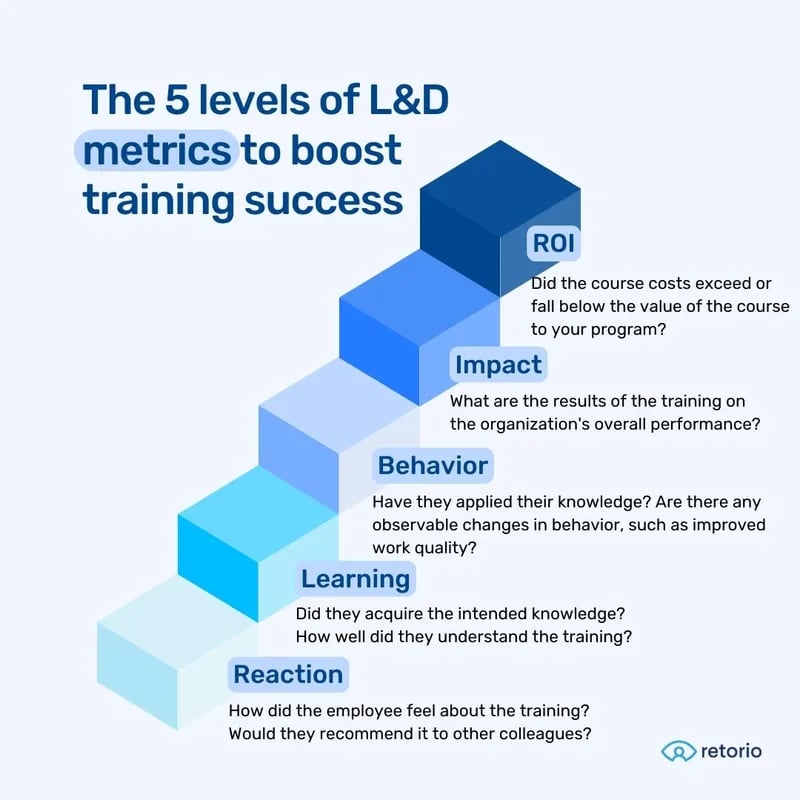As a Learning and Development (L&D) manager, your role is instrumental in shaping the growth and success of your organizational performance. In today's competitive business landscape, the value of L&D programs cannot be overstated, as they play a crucial role in empowering employees and building a culture of continuous learning and improvement.
According to a 2020 study from CIPD, only 16% of L&D employees tracked how learning was applied to their day-to-day work, and only 14% measured the impact on business strategy. However, improvements took place in 2021 when the Learning and Skills at Work study in 2021 showed that over 80% of respondents indicated their learning strategy aligns with company objectives, while also being clear about how the learning they executives provides value to their organization.
From bolstering employee engagement and employee retention to identifying skills gaps and optimizing training programs, these 5 must-track L&D measurements offer invaluable insights to enhance the overall learning experience in your organization.
What's in this post?
What are learning and development measurements?
A Learning and development measurement, also known as learning and development metrics, is used to assess how well a company's training and development initiatives are working. These measurements play a crucial role in enabling companies to assess the results of their training program on employee performance, organizational strategy, and business impact. This results in an increase in the training effectiveness of any company's training program which contributes to the overall business success.
At their core, L&D measurements primarily serve the following four objectives:
-
Analyze an individual's training program's effectiveness.
-
Evaluate the success of the training.
-
Align learning to organizational objectives.
-
Analyze each training component's effectiveness individually.
However, gaining unbiased insights into the outcomes and effects of training interventions is the main goal of learning and development measurements.
Organizations can evaluate the success of their learning programs and spot opportunities for development by gathering both quantitative and qualitative data. Making educated decisions, improving training techniques, and ensuring that learning initiatives are aligned with organizational goals and all objectives are realistic to achieve with the use of the L&D measurements.
Statistics have shown that in 2022, companies in the United States spent $92 billion on learning and development.

Why are learning and development measurements important?
According to LinkedIn Learning's 2023 Workplace Learning report, 89% of L&D experts believe that proactive employee skill development helps companies to succeed in the rapidly evolving business environment of the future.
Learning and Development measurements are important for a number of reasons, including the fact that they are key to creating effective training programs and evaluations and promoting organizational progress.
Companies that provide development opportunities are generally regarded more favorably by employees who prioritize professional development. However, a common issue arises where training offered may not align with employees' actual learning needs to advance in their careers.
Consequently, this disconnect leads to decreased working engagement, and employees may view the training as an inconvenient interruption that offers no real benefits to their personal growth and development.
With that being said, here are a couple of key reasons why L&D measurements are important to ensure positive and productive growth and action:
-
Training evaluation: Organizations can accurately evaluate the efficacy of their learning programs by collecting and evaluating data on training completion rates, skill gain, and training satisfaction. By identifying areas of strength, weakness, and improvement, this evaluation assists in maximizing the impact of training initiatives.
-
Aligning with business objectives: To achieve intended business goals, everything - from course content to personalized training - must be created to build on the learner's capabilities. L&D measurements ensure that employee development aligns with the organization's strategic business objectives. By also selecting relevant KPIs that directly relate to desired outcomes, such as increased productivity or improved customer service, organizations can focus their training efforts on skills and competencies that contribute directly to achieving business goals.
-
Data-Driven decision-making: Organizations can learn a lot about the efficiency of their training initiatives by examining the interpreting the data that has been gathered. The ability to make data-driven decisions regarding resource allocation, training priorities, and alterations to learning methods gives L&D managers and business executives more control over their decisions.
-
Resource optimization: L&D measurements themselves cannot reveal business ROI. However, this metric can assist you to understand employee performance and assess how effectively that performance contributes to your organization's return on investment (ROI) when utilized to achieve its four primary goals. This is accomplished by assessing the success of the training. To put it another way: by determining the effect that training has on how well employees are performing.
-
Continuous improvement: Regularly tracking and analyzing L&D measurements foster a culture of continuous improvement. By identifying areas for enhancement and making data-driven adjustments to training content, organizations can continuously improve the effectiveness of their training programs. This iterative process keeps all training initiatives relevant and aligned with changing business needs.
-
Talent development and Employee engagement: Organizations can pinpoint possibilities for employee growth and development by tracking the effects of training on performance and skill acquisition. Employees that are more skilled and engaged are more likely to contribute to the accomplishment of the organizational goals and would stay committed to the organization in the long run.
What are the 5 must-track Learning and Development measures?
Now to the most important part - The effectiveness of training can be assessed using a variety of learning metrics. Businesses can also create unique measures that take into account aspects unique to their industry or approach to training.
Metrics for measuring training effectiveness should be based on real-life data and make an honest effort to represent the results of L&D initiatives.
1. Training completion rate
The training completion rate is a metric that measures the percentage of employees who successfully complete their assigned training programs within a specific time frame. It can be calculated with the following formula:
Completion rate = Number of employees completed training ÷ Total number of employees enrolled) x 100
This measure assesses the engagement and commitment of employees toward their learning initiatives. A high completion rate indicates that employees are actively participating in training, which is essential for knowledge and skill acquisition. On the other hand, a low completion rate may suggest potential issues with the training program or training content, delivery methods, or employee motivation.
However, having a high completion rate does not guarantee that your team is receiving quality training. To get a whole view of how your employees are doing, scores, staff feedback, and completion rates must be evaluated holistically.
To avoid this, be careful to communicate with your employees often while you conduct your L&D program. Regular check-ins are what will do the job for you. In any case, it is crucial to stay on schedule by getting employee input and keeping track of completions.
2. Skill acquisition and application
This measure evaluates the extent to which employees acquire new skills through training and their own ability to apply these skills effectively in their job roles and daily tasks.
Skill acquisition is typically assessed through pre and post-training assessments or performance evaluations. It can also be calculated with the assessment pass rate formula:
Assessment Pass Rate = (Number of employees that pass a training ÷ Total number of employees that participated) x 100
A significant increase in employees' performance or competency levels after training indicates that a successful skill acquisition has resulted from the training program. However, skill application is equally crucial. Tracking how employees utilize their new knowledge in real-life scenarios demonstrates the practical impact of training on job performance. For example, do they respond better to customers?
3. Training impact on performance
The training impact on performance measure analyzes the correlation between training initiatives and improvements in job performance or productivity. This metric focuses on measuring the tangible benefits of training in terms of actual job outcomes. It can be evaluated through performance metrics, productivity indicators, customer satisfaction ratings, or other relevant key performance indicators.
A positive impact on performance indicates that training efforts are directly contributing to the organization's success.
4. Employee feedback and satisfaction
Understanding the success of training programs depends on getting input from employees about their learning experiences.
Employee Feedback and Satisfaction measures how satisfied participants are overall with the training's subject matter, methods of instruction, and learning environment.L&D managers may gather information, pinpoint strengths and flaws, and make data-driven modifications to improve future training programs by conducting post-training surveys or focus groups.
This can be measured with the following formula:
Customer Satisfaction Rating = Number of positive customer responses ÷ Total number of customer responses
5. Return on Investment (ROI) of training
An important metric for evaluating the financial return on investment for learning and development programs is the ROI of Training.
It entails weighing the expense of training against the advantages brought forth by enhanced performance, higher output, decreased turnover, or other quantifiable results.
The allocation of resources to employee development initiatives is justified by a good ROI, which shows that the organization's investment in learning and development is producing real results.
This can be calculated with the following formula:
Training ROI = Change in profit made as a result of training ÷ Total cost of training

What is the Kirkpatrick model?
The Kirkpatrick Model is a widely used technique for assessing the success of training and education initiatives. It evaluates training techniques, both official and informal, and ranks them according to four levels of standards: reaction, learning, behavior, and impact. Some organizations also include ROI as an additional 5th level.
Below is an explanation of each level of the Kirkpatrick model
| Level 1: Reaction - How did learners respond to the training? | L&D supervisors evaluate how trainees are responding to the training program. This level focuses on gathering participant feedback regarding their training experience, including their views of the program's content, methods of delivery, and facilitators, as well as their opinions and levels of satisfaction. Typically, surveys, questionnaires, or focus group discussions are used to collect feedback. |
| Level 2: Learning - What knowledge and skills did the learners acquire? | Level 2 assesses how much training-related information and skills were learned by participants. To quantify learning gains and improvements in certain abilities, this evaluation frequently entails performing pre- and post-training evaluations. |
| Level 3: Behavior - Did learners apply what they learned on the job? | This is where measuring the application of learning in the workplace comes into focus. Managers of L&D evaluate participants' use of newly learned information and skills about their employment duties. This assessment often includes observation, performance reviews, and input from peers or superiors. |
| Level 4: Results - What is the impact of the training on business outcomes? | This level assesses how the training has affected the organization's performance and financial health more broadly. Key performance indicators (KPIs) for company objectives like better productivity, lower costs, more customer happiness, or higher staff retention rates are examined by L&D managers. |
| Level 5: Return on Investment - What is the financial return on the training investment? | This level evaluates the investment in training's financial return. Calculating the financial gains from the training, such as increased revenue or cost savings, and contrasting them with the overall cost of putting the training program into place is also necessary. When making decisions about future investments in employee development, L&D managers may use the ROI calculation to strengthen their case to organizational stakeholders for the value of training efforts. |
💡Below is an infographic that summarizes the 5 levels of L&D metrics that will help your company effortlessly boost your training success:
A bonus point with Retorio is that you get the opportunity to cut down your L&D costs with our AI-powered platform. Retorio's platform elevates the learning and development experience by harnessing the power of AI to deliver personalized feedback and in-depth insights into individual employees' behaviors.
This approach empowers L&D professionals to pinpoint precise areas that require improvement, enabling them to curate tailored training programs for maximum impact.
With Retorio's platform, you can also gain access to comprehensive analytics and reporting features, allowing you to gauge the ROI of your L&D initiatives. Armed with data-driven insights, you can make informed decisions about future training endeavors, ensuring that your L&D budget is optimally utilized. Additionally, the robust evidence provided by the platforms serves as a compelling justification for investing in ongoing employee development, solidifying the importance of nurturing a skilled and motivated workforce.
You can begin implementing it to your own L&D training experience now with just a simple click of the button below!
FAQ
Learning and Development Key Performance Indicators (KPIs) are used to evaluate the effectiveness and impact of learning and development programs inside an organization.
These KPIs offer insightful data on the efficacy of employee development, training programs, and their L&D function as a whole. Organizations can make data-driven decisions, pinpoint areas for development, and make sure that learning and development initiatives are aligned with the company goals by monitoring these KPIs and avoiding ineffective training programs.
Employee training metrics are measurements that determine how well a certain training program is working. These metrics may also include information on how quickly employees pass training exams and how quickly their skill level increases, which may assist businesses analyze the return on investment that a training program offers to their business. Companies frequently select their preferred training metrics based on their long-term objectives.




